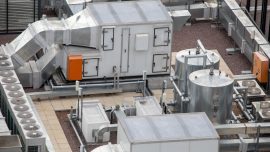
HVAC System Design Considerations for Large Educational Facilities
For educational facilities such as schools and universities, good HVAC system design is imperative to keep the environment comfortable, safe, and conducive to learning.
With larger-sized buildings come more complex needs – from reliability to efficiency – requiring careful HVAC system selection. This blog post will examine some of the key considerations when designing an HVAC system for large-scale educational facilities so that you can make informed decisions about your building’s ventilation and air conditioning.
Identifying the Heat Load – Assessing the size and scope of facilities to determine the appropriate HVAC system
Heating, ventilation, and air conditioning (HVAC) systems are critical to any facility, ensuring the comfort and safety of those inside.
But with so many factors to consider, identifying the proper heat load for a building can be challenging. Facility managers must consider factors such as insulation, the number of occupants, and the size and orientation of windows.
Inadequate HVAC systems are not only uncomfortable for inhabitants, but they can also lead to increased energy costs and poor air quality. By correctly identifying the heat load of a facility, building owners can ensure that they have the right HVAC system for their needs and improve the overall comfort and health of their occupants.
Design Parameters – Exploring factors such as temperature control, humidity levels, ventilation, and energy efficiency
Design parameters are crucial in ensuring a building is visually appealing but also functional and comfortable.
Factors such as temperature control, humidity levels, ventilation, and energy efficiency must be considered when designing a space. Temperature control can affect the comfort level of occupants and must be carefully managed through effective insulation and heating or cooling systems.
Maintaining optimal humidity levels is essential to prevent mold growth and improve indoor air quality. Proper ventilation ensures that fresh air is circulating while avoiding energy waste. Energy efficiency is also central to design parameters since it reduces reliance on non-renewable energy sources and saves costs over the long term.
Overall, design parameters are critical to creating spaces prioritizing functionality, comfort, and sustainability.
Equipment Selection – Considering equipment sizing and selection for both new construction and retrofitting existing systems
When building or upgrading a system, equipment selection is a critical step that should always be considered.
Whether starting from scratch or retrofitting an existing network, the right equipment can mean the difference between a highly efficient operation and a constant source of headaches.
The key is to carefully consider your needs and choose equipment that is appropriately sized, reliable, and suited to your specific application. Making the right choices upfront can save you time, money, and frustration, helping you achieve the level of performance and productivity you need to succeed.
So, if you’re getting ready to embark on a new project or looking to upgrade your current system, don’t wait – start thinking about equipment selection today!

Installation Guidelines – Clarifying the requirements for safely installing HVAC systems in educational facilities
Following the proper installation guidelines is imperative when setting up HVAC systems in educational facilities.
Safety should be the top priority, and any deviation from the required procedures could lead to potential hazards for staff and students. From the equipment configuration to the placement of ductwork, each step must be executed with precision to ensure that the system runs smoothly and efficiently.
By clarifying the requirements for installation, we can minimize the risks and create a safe and comfortable environment for learning. Ultimately, investing the time and resources into a proper installation will pay off in the long run, providing a reliable and effective HVAC system for years to come.
Maintenance Plan – Outlining a plan to keep HVAC systems running efficiently over time
Proper maintenance is crucial for keeping any HVAC system running at its best.
Regular maintenance allows HVAC systems to quickly become efficient, leading to higher energy bills and potential breakdowns. A comprehensive maintenance plan should include frequent filter changes, system inspections, cleaning of coils and fans, and calibration of controls.
By keeping up with routine maintenance, HVAC systems can operate at peak efficiency, saving energy and money while prolonging the system’s lifespan. An effective maintenance plan is much more than just a checklist, and it’s an investment in the longevity and performance of any HVAC system.

Long-Term Costs & Benefits – Exploring how a properly designed and installed HVAC system can reduce long-term operating costs while improving safety, comfort levels, and overall performance of the facility
The correct HVAC system can make all the difference in a facility by improving safety, comfort levels, and overall performance while reducing operating costs.
Proper design and installation of an HVAC system can enable more efficient energy use, leading to significant cost savings. Beyond financial benefits, many intangible benefits come with a well-functioning HVAC system, such as improved air quality and increased productivity.
It’s essential to consider the long-term benefits of an HVAC system rather than just the upfront costs. By investing in a high-quality, properly designed, and installed HVAC system, facility managers can ensure that their building is a safe, comfortable, and energy-efficient environment for years to come.
Conclusion
In conclusion, HVAC systems are essential for educational facilities.
Much thought and care must go into designing, installing, and maintaining these systems. The proper heat load must be identified, design parameters must be explored, equipment must be selected wisely and appropriately installed, a maintenance plan must be created regularly, and all of these steps are done with a view to long-term costs and benefits.
A well-designed HVAC system can make such a difference to the safety and performance of an educational facility over time. If you need assistance with any aspect of your educational facility’s HVAC system, please do not hesitate to contact M&T Air Conditioning today so we can discuss how our services would benefit you.







